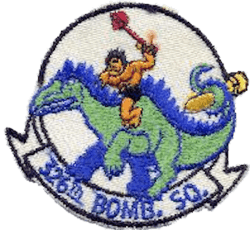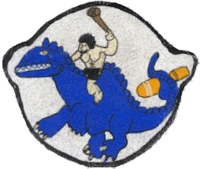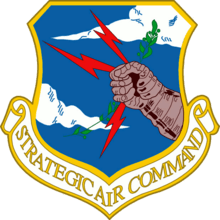326th Bombardment Squadron
The 326th Bombardment Squadron is an inactive United States Air Force unit. Its last was assigned to the 4141st Strategic Wing, stationed at Glasgow Air Force Base, Montana. It was inactivated on 1 February 1963.
| 326th Bombardment Squadron | |
|---|---|
 Emblem of the 326th Bombardment Squadron | |
| Active | 1942–1963 |
| Country | United States |
| Branch | United States Air Force |
| Type | Bombardment |

History
World War II
Activated as a B-17 Flying Fortress heavy bomb squadron in early 1942; trained by Third Air Force in the southeastern United States. Received new B-17F aircraft and conducted training at Mac Dill and Sarasota Fields, Florida. As part of its training program, the Squadron flew anti-submarine operational missions.
Deployed to European Theater of Operations (ETO), being assigned to VIII Bomber Command in England, the first heavy bomber squadron to fly the North Atlantic ferry route to Prestwick, Scotland as it deployed to England and was assigned to VIII Bomber Command at RAF Bovingdon. At Bovingdon, the squadron exchanged B-17Fs with the 97th Bombardment Group's B-17E aircraft. The 97th BG would move to North Africa and assigned to Twelfth Air Force as part of the Operation Torch landings. At Bovingdon, The squadron was directed to set up and operate the 1/11 CCRC (Combat Crew Replacement Center). The Squadron flew four combat missions beginning on 6 September 1942. Upon completion of its training mission, the 326th moved to RAF Alconbury on 6 January 1943 where it and its parent 92d Bombardment Group underwent reorganization. When they emerged in May 1943, the 92 BG and 326 BS were ready for combat. The group's B-17s, flew their first post-reorganization combat mission on 15 May 1943.
In the fall of 1943 longer range raids began, and resulted immediately in heavy losses. One of these missions was flown on Thursday, 14 October 1943, against the ball bearing plants at Schweinfurt. For what was to become a famous mission called "Black Thursday", the 326th led the group in the lead wing with 21 aircraft; one 326th Squadron and two other Group aircraft aborted, and of the 12 group aircraft that made it back to England, only 3 came home that day.
Some of the notable successes of the squadron included missions against German troop concentrations in Normandy after D-Day. On 24 July 1944 the Squadron participated in a raid that virtually destroyed the elite "Panzer Lehr" armored division outside St. Lo. In support of Operation Cobra 1,800 aircraft targeted a narrow front. Artillery positions were wiped out, tanks overturned and buried, infantry positions flattened and all roads and tracks destroyed. This broke up the German defenses such that they could be penetrated.
Another notable success was a raid against the virtually indestructible German submarine pens at IJmuiden. Using the British Disney bomb, a rocket-propelled "bunker buster", the Squadron destroyed these pens in a single raid after hundreds of conventional bombs dropped in earlier raids had failed.
The Squadron flew its last mission of the Second World War on 25 April 1945. By the end of the war against Germany, the group had flown over 300 combat missions, 154 aircraft missing in action and more than 150 returned with battle damage that it would not fly again,
Reassigned to Air Transport Command in June 1945 as part of the Operation Green Project and Blue Projects. Used B-17s as transports, flying demobilized personnel to ATC sites in Morocco and Azores from France. Aircraft turrets were removed and re-skinned, the bomb racks removed, flooring and seating installed to accommodate 30 passengers. The flight crew was reduced to pilot, co-pilot, navigator, flight engineer and radio operator. In addition the engineer and radio operator would act as stewards, to assist and calm the many first time flyers. Inactivated in February 1946.
Strategic Air Command

Reactivated as a Strategic Air Command B-29 Superfortress squadron in July 1946. Performed strategic bombardment training and operations directed by the Strategic Air Command (SAC). In March 1948 deployed to England and Germany to support the Berlin Airlift.
Deployed to Far East Air Forces and flying combat missions over North Korea. Under control of the FEAF Bomber Command (Provisional) until 20 October, the squadron bombed factories, refineries, iron works, hydroelectric plants, airfields, bridges, tunnels, troop concentrations, barracks, marshalling yards, road junctions, rail lines, supply dumps, docks, vehicles and other strategic and interdiction targets.
Released from combat by General MacArthur on 20 October 1950. Many of the still operational B-29s remained with Far East Air Forces to serve on with the 19th BG and 307th BG at Kadena AB, Okinawa; and the 98th BG at Yokota, Japan. Returned without most personnel and equipment to Spokane AFB, Washington in late October and November 1950.
Re-equipped with B-36 Peacemaker intercontinental strategic bomber in 1951. Engaged in training operations on a worldwide scale. Deployed in August 1953 to the Far East was to survey suitable bases for B-36 use and to reinforce the Korean armistice of July 1953. 20 B-36D aircraft landed at Kadena AB, for 'Operation Big Stick'. B-36 aircraft visited Yokota AB and Anderson AFB Guam. The squadron returned to Fairchild after a short stay. Redeployed to Guam 14 October 1954 for 90 days, which established a succession of deployed B-36 squadrons to maintain a heavy bomber presence in the western Pacific. Returned for its second 90-day deployment in April 1956.
During the 1956 deployment to Guam, four 327th B-36J aircraft were deployed to Hickam AFB HI. They would support the 1956 Eniwetok Tests. On 15 April 1952, a borrowed 327th B-36 with a 326th crew crashed on takeoff, killing 15 crewmen, 2 survived, severely burned. The Magnesium Overcast would burn very hot. In May 1955, the 326th was awarded the Air Force Outstanding Unit Award (AFOUA) for Operation Big Stick.
In July 1960, the 327th began the movement of the squadron’s personnel, aircraft and equipment to Glasgow AFB, Montana. This was the completion of the dispersal program to reduce vulnerability of large (three squadron 45 B-52) unit at one base. The 326th would move to Glasgow AFB MT in February 1961. On setup at Glasgow, the squadron resumed alert duties and training under the command of the 4141 Strategic Wing.
In an effort to honor heritage units of the past, on 1 February 1963, the 4141 SW and 326th BS were inactivated when SAC inactivated its provisional Strategic Wings, redesignating them permanent Air Force Wings. Squadron was inactivated with aircraft/personnel/equipment being redesignated 322d Bombardment Squadron in an in-place, name-only transfer.
Lineage
- Constituted 326 Bombardment Squadron (Heavy) on 28 January 1942
- Activated on 1 March 1942
- Redesignated 326 Bombardment Squadron, Heavy on 29 September 1944
- Inactivated on 28 February 1946
- Redesignated 326 Bombardment Squadron, Very Heavy on 15 July 1946
- Activated on 4 August 1946
- Redesignated: 326 Bombardment Squadron, Medium on 28 May 1948
- Redesignated: 326 Bombardment Squadron, Heavy on 16 June 1951
- Discontinued and inactivated on 1 February 1963, aircraft and personnel reassigned to the 322d Bombardment Squadron.
Assignments
- 92d Bombardment Group, 1 March 1942 – 28 February 1946
- 92d Bombardment Group, 4 August 1946
- Attached to 92d Bombardment Wing, 16 February 1951 – 15 June 1952
- 92d Bombardment (later, 92d Strategic Aerospace; 92d Bombardment) Wing, 16 June 1952
- 4141st Strategic Wing, 1 September 1958 – 1 February 1963.
Stations
|
|
Aircraft
- B-17 Flying Fortress, 1942–1946
- B-29 Superfortress, 1946, 1947–1951
- B-36 Peacemaker, 1951–1957
- B-52 Stratofortress, 1957–1963
References
- Notes
- Bibliography
- Maurer, Maurer, ed. (1982) [1969]. Combat Squadrons of the Air Force, World War II (PDF) (reprint ed.). Washington, DC: Office of Air Force History. ISBN 0-405-12194-6. LCCN 70605402. OCLC 72556.
![]()
